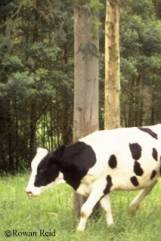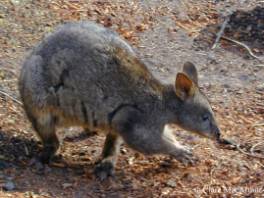Protection
from Stock, Vermin and Wildlife

It is often necessary to protect trees and
saplings from livestock, wildlife (such as wallabies and kangaroos)
and vermin (such as rabbits and hares). The decision to protect
your seedlings, or to implement control measures on local pests,
depends upon how much damage can be tolerated by the trees before
economic or severe physiological damage is caused. It also depends
upon a variety of additional factors including: where the trees
are planted, the level of exposure, the cost of replanting and
level of acceptable loss. Larger trees can tolerate far more
leaf damage than newly planted seedlings, providing there is
not severe damage to the new leaf bud.
Stock
Fencing is commonly used to protect trees
from stock, preventing plants from being eaten or crushed
and preventing stock from restricting growth by compacting
soil around the roots. Sheep, cattle and horses need to be
kept away from newly planted trees until they reach a height
where young leaves cannot be eaten and to an age where they
can withstand trunk damage.
Vermin
Exotic pests are those animals that are
not native to a particular area or habitat. Different animals
may be registered as pests in different states. The introduced
rabbit eats a wide variety of plant species and can ringbark
young trees. Combinations of fencing, shooting and mechanical
(warren ripping and wool plugs) and chemical methods (fumigating
and poisoning) are more effective in controlling rabbits than
using these methods individually.
Wildlife
It is important to try to become aware
of what wildlife is in your area and how fencing might affect
the movement of wildlife through your property. While some
native animals that damage trees are pests, some types may
cause negligible amounts of damage and are best left alone.
Wallabies, kangaroos and birds can be responsible for decimating
trees. Land clearing and declining remnant vegetation can
reduce the food choices, perhaps forcing animals to feed on
seedlings as a last resort. Attempting to maintain or improve
biodiversity of your property will help offer a variety of
plants and organisms as food for local wildlife.

Birds
Trees can also suffer extensive damage
from birds. For example, Sulphur-crested cockatoos are known
to rip up seedlings and chew bark and trunks in order to sharpen
their beaks. They flock in large numbers and can also cause
damage when roosting in trees. Strips of vegetation around
seedlings can offer some protection. Contact your local council
for advice on bird control measures. Scare guns have been
successful in some cases, providing the guns are often, moved
regularly and used as soon as the birds arrive.
Tree Guards
The cost of some of these guards may exceed
the price of the seedling, take longer to install than planting
and may require further maintenance to remove. Individual
tree guards can be economically viable for small plantings
or for widely-spaced trees. Different types of guards are
available; most plastic guards are UV-stable and are supported
by three stakes placed in a triangle around the seedling.
Plastic guards can assist growth rate by creating a favourable
microclimate for growth by protecting the plant from wind
and water loss. However wind resistant guards do not encourage
strong root systems. It is important to remove the guards
once the seedlings have become well established so that they
do not restrict further growth.
Fencing
Fencing can protect seedlings from domestic
stock and some types of vermin and wildlife and is more cost
effective than individual tree guards. Excluding stock will
also prevent soil compaction and erosion. Electrical fencing
may be cheaper than conventional fencing but will require
regular checking and maintenance. Some types of fencing may
not be effective in preventing browsing from smaller animals
or possums. Protection from rabbits will require that netting
is buried along the fence line to 150mm or with netting bent
at the base to lie on the ground in the direction of approaching
rabbits.
In many localities the construction of fences
may need to follow certain guidelines. For example the Fences
Act in different states (Northern Territory, South Australia,
Victoria) outlines provisions relating to different types
of fences. Fencing should be carried out before planting and
is easier when the soil is moist. Cattle and horses will require
sturdier fences than sheep.
No control method is full proof and regular
monitoring of your trees for any signs of damage is important
to determine if you are developing pest problems.
Planting
trees to reduce the impact of pests
Designing revegetation projects
for wildlife
Back to top
|
